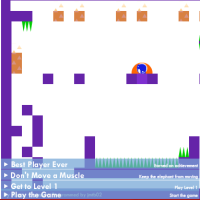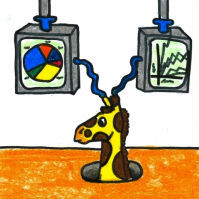My latest piece has gone up at GameSetWatch. It’s called “Opposing Goals in Minotaur China Shop,” and it’s about how that game balances difficulty and player interest by offering two opposing player goals.
Category Archives: Blogs
Achievement Unlocked

I love digital games that play with the oddities of the medium. Metal Gear Solid shows psychic powers by reading your memory card, and Karoshi 2.0 joyfully breaks the rules of gaming. And now we have a game that pokes fun at the phenomenon of achievements: “Achievement Unlocked.”
TIGSource Commonplace Book Competition
The TIGSource Commonplace Book Competition is in voting right now. It’s a competition where developers are asked to make games out of entries in H.P. Lovecraft’s scrapbook. I’ve gotten around to playing the games, and here’s a few I found interesting. If I didn’t mention a game, that doesn’t mean it’s not good; these are just the ones that jumped out at me.
The Eye of Boccob
The Eye of Boccob is a prestige class for Dungeons & Dragons Edition 3.5. I used it for a creepy NPC in a campaign I am running, when I realized that I needed an NPC that was capable of teleporting large numbers of people. It grew from there into a character that my player loved to hate. If you intend to use this prestige class in a campaign, keep in mind that it was designed to be a non-combat NPC; I make no guarantees regarding game balance or feasibility of this class for PCs. However, it could prove to be a useful utility class for a group that desires heightened abilities of surveillance and transportation. The full class description follows.
Necropolis Fix and Unit Testing
The attention that “The Majesty of Colors” received has caused a small increase in the plays of my previous game, Necropolis. As a result, I got a bug report from a Kongregate user on Necropolis that let me track down a bug that had eluded me for months. I feel dumb for causing the bug in the first place, and it’s a perfect example of where unit testing is very useful.
The Undeath of Uru Live
Myst Online: Uru Live will soon be immortal. Cyan Worlds is releasing the ill-fated MMO as an open-source project. This is great news; Uru always had more potential than its codebase and its funding allowed. However, it’s also terrible news, as it seems likely that Cyan will not be creating new content themselves for quite some time. Still, with the likes of Andrew Plotkin among the game’s fans, I feel confident that at least some quality content will emerge.
Hope for the Future
Premier video game industry news site Gamasutra just released their top 5 indie games of the year. Number one is Daniel Benmergui’s wonderful “I Wish I Were the Moon,” which I’ve mentioned before. Number two is “Everybody Dies,” third-place winner in the 2008 Interactive Fiction Competition and a game I’ve yet to play. These two selections give me a great deal of hope for the future of interactive entertainment.
My Visit to the Land of Dream

I’m a bit miffed. I just finished my latest game, called “Bars of Black and White.” It’s an intentionally roughly-drawn first-person point-and-click puzzling game. To celebrate, I decided to finally play Jonas Kyratzes’s latest game, which to my dismay turned out to be a roughly-drawn first-person point-and-click puzzling game. And it was better than mine.
The Strange and Somewhat Sinister Tale of the House at Desert Bridge is the newest game by the creator of titles like The Museum of Broken Memories and Last Rose in a Desert Garden. Of course, it’s not really a game; it’s a “transdimensional portal to the Lands of Dream,” according to the premise. And it’s a great experience.
Remember when you were a kid and you’d just played Myst and Dare to Dream, and you found Hypercard on your school computers, and you decided to make an adventure game? And it was going to be the coolest game ever, with all sorts of secrets and jokes and you spent hours drawing the backgrounds in a wide-ruled spiral notebook?
First LORE Playtest
I’ve mentioned before that I’m working on a tabletop roleplaying system. LORE, or the Lightweight Omnipotent Roleplaying Engine, is designed to be versatile, quick-playing, and easy to pick up. Last Saturday, I ran my first-ever playtest of the system.
As with digital games, playtesting is the only way to really get a feel for a tabletop roleplaying system. Some systems look great on paper, but don’t do so well at the gaming table. Conspiracy X‘s revised edition (I haven’t played 2.0) is one of these. It’s a great setting, with some unique mechanics, but the basic rolling is a nightmare when you actually try it out. So even though I’d done brute-force statistical analysis of LORE‘s dice-rolling, it was only in play that I could get a real test. So how’d it turn out?
Games From a Parallel Dimension

I love games that come from another world. Odin Sphere is a game from a world where 3D never caught on, and people kept making 2D games with more and more advanced hardware. The Fool’s Errand is a game from a parallel universe populated entirely by clumsy geniuses, with brains the size of cities but the tragic inability to play action-oriented games. And Scenic is a game from a dimension where people really loved Mode 7 for some reason. Allow me to elaborate.